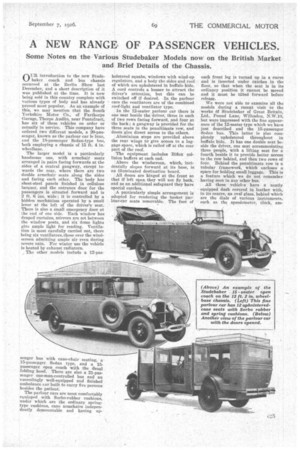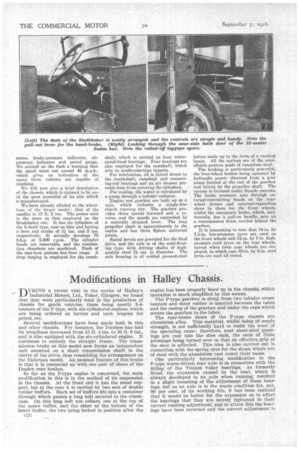A NEW RANGE OF PASSENGER VEHICLES.
Page 47

Page 48

If you've noticed an error in this article please click here to report it so we can fix it.
Some Notes on the Various Studebaker Models now on the British Market and Brief Details of the Chassis.
Ointroduction to the new Studebaker coach and bus chassis occurred at the Berlin Show last December, and a short description of it was published at the time. It is now being sold in this country complete with various types of body and has already proved most popular. As an example of this, we may mention that the South Yorkshire Motor Co., of Farthorpe Garage, Thorpe Audlin, near Pontefract, has six of these vehicles on order or actually in service. This company have ordered two different models, a 20-pa5senger, known as the parlour car le luxe, and the 1S-passenger Sedan-type bus, both employing a chassis of 15 ft. 4 in. wheelbase.
The larger model is a particularly handsome one, with armchair seats arranged in pairs facing forwards at the sides of a central gangway, except towards the rear, where there are two double armchair seats along the sides and facing each other. The body has sheet-steel panels finished in cellulose lacquer, and the entrance door for the passengers is situated forward and is 2 ft. 6 ins. wide ; it is controlled by a hidden mechanism operated by a small lever at the left of the driver's seat. There is also a small emergency door at the end of one side. Each window has draped curtains, mirrors are set between the window posts, and six dome lights give ample light for reading. Ventilation is most carefully carried out, there being six ventilators, those over the windscreen admitting ample air even during severe rain. For winter use the vehicle is heated by exhaust radiators.
, The other models include a 12-pas
senger bus with cane-chair seating, a 15-passenger Sedan type, and a 15passenger open coach with the ifsual folding hood. There are also a 21-passenger one-man-controlled bus and an exceedingly well-equipped and finished ambulance car built to carry five persons besides the patient.
The parlour cars are most comfortably equipped with Sorbo-rubber cushions, under which are the ordinary springtype cushions, cane armchairs independently demountable and having up holstered squabs, windows with wind-up regulators, and a body the sides and roof of which are upholstered in buffalo hide. A cord controls a buzzer to attract the driver's attention, but this can be switched off if desired. In the parlour cars the ventilators are of the combined roof-light and ventilator type.
In the 12-seater parlour car there is one seat beside the driver, three in each of two rows facing forward, and four at the back ; a gangway is provided for the three seats in the penultimate row, and dOors give direct access to the others.
Aluminium steps are provided above the rear wings to give access to a luggage space, which is railed off at the rear part of the roof.
The equipment includes Biflex collision buffers at each end.
, Above the windscreen, which, incidentally slopes forward at its base, is ai illuminated destination board.
All doors are hinged at the front so that if left open they will not fly back, and as an additional safeguard they have special catches.
A particularly simple arrangement is adopted for rendering the basket parlour-ear seats removable. The foot of
each front leg is turned up in a curve and is inserted under catches in the floor, so that when the seat is in its ordinary position it cannot be moved and it must be tilted forward before refease.
We were not able to examine all the models during a recent visit to the works df Studebaker of Great Britain, Ltd., Pound Lane, Willesden, N.W.10, but were impressed with the fine appearance of the 12-seater type which we have just described and the 15-passenger Sedan bus. This latter is also completely upholstered throughout in buffalo hide. It has one double seat beside the driver, one seat accommodating three people, with a lifting seat for a fourth beside it to provide better access to the row behind, and then two rows of four. Behind the penultimate row is a tubular framework, which encloses a space for holding small luggage. This is a feature which we do not remember having seen in any other bus.
All these vehicles have a neatly equipped dash covered in leather with, in its centre, an oval glass, behind which are the dials of various instruments, such as the speedometer, deck, am meter, brake-pressure indicator, oilpressure indicator and petrol gauge. We noticed on the dash a warning that the speed must not exceed 45 m.p.h., which gives an indication of the speed these vehicles are capable of reaching.
We will now give a brief description of the chassis, which is claimed to be one of the most powerful of its size which is manufactured.
We have already alluded to the wheelbase of the larger model ; that of the smaller is 13 ft. 2 ins. The power unit is the same as that employed on the Studebaker car. It has six cylinders of the L-head type, cast en bloc and having a bore and stroke of 3i ins. and 5 ins. respectively. It actually develops 75 b.h.p. at 2,400 r.p.m. The cylinder heads are removable, and the combustion chambers are machined. Each of the cast-iron pistons has four rings. A drop forging is employed for the crank
shaft, which is carried on four whitemetal-lined bearings. Four beatings are also employed for the camshaft, which acts on mushroom-type tappets.
For lubrication, oil is forced direct to the crankshaft, camshaft and connecting-rod bearings and an air cleaner prevents dust from entering the cylinders.
For cooling, the water is circulated by a pump through a tubular radiator.
Engine and gearbox are built up as a unit, which includes a single-disc clutch running dry. The gearbox provides three speeds forward and a reverse, and the speeds are controlled by a centrally situated lever. The long propeller shaft is approximately in the centre and has three Spicer universal joints.
Spiral bevels are provided for the final drive, and the axle is of the semi-floating type, with driving shafts of highquality steel 2A ins, in diameter. The axle housing is of welded pressed-steel halves made up in the form, of a vertical banjo. All the springs are of the semielliptic pattern made of vanadium steel.
The braking is particularly powerful, the four-wheel brakes being operated by hydraulic power obtained from a gear pump located at the end of the gearbox and driven by the propeller shaft. The system is licensed under Staude patents. The brake pressure acts through external-contracting bands on the rearwheel drums and internal-expanding shoes in those for the front wheels, whilst the emergency brake, which, incidentally, has a pull-on handle, acts on a transmission drum carried behind the gearbox.
It is interesting to note that 34-in. by 7.3-in, low-pressure tyres are used on the front wheels and 34-in. by 7-in, highpressure cord tyres on the rear wheels, except when twin rear wheels are employed, in which case 82-in. by 6-in, cord tyres are used all round.












































































































